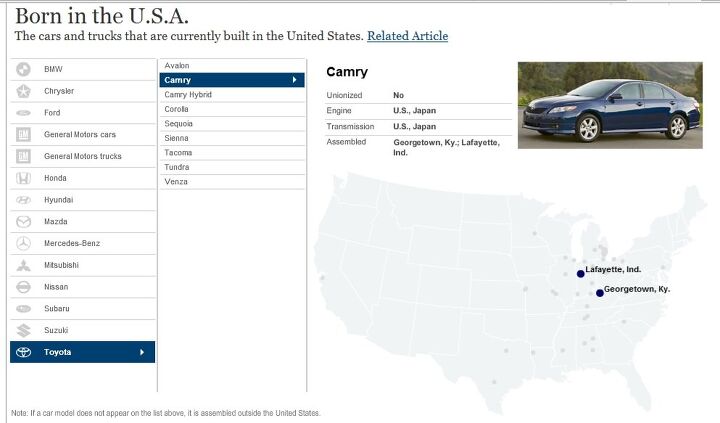2 Views
Would The Real Domestic Auto Industry Please Stand Up?
by
Edward Niedermeyer
(IC: employee)
Published: June 22nd, 2009
Share
The NY Times has an interactive widget that shows all domestically-produced vehicles, their point of assembly, whether they’re union-assembled, and where their engine and transmission were produced. What, no parts-content-origin-percentages? Oh well, the message is clear: Americans build tons of hugely popular automobiles.
Edward Niedermeyer
More by Edward Niedermeyer
Published June 22nd, 2009 12:51 PM


































Comments
Join the conversation
The Pontiac Vibe is listed as a truck while its Toyota equivalent isn't listed, even if it is a truck.
psarhjinian That is an additional but separate issue. When comparing two equal vehicles the additional labor cost from the excessive union wages can not be justified in the form of higher quality or productivity. Actually it is the opposite, internal quality audits always showed the Mexican plants ahead. (This is GM, I don't know about others, but would expect the same)
"When comparing two equal vehicles the additional labor cost from the excessive union wages can not be justified in the form of higher quality or productivity." This is incorrect on a general basis. You can be paid more if you are more productive as your unit cost may be lower. This is a gross generalization, though, and in some instances your assertion would be correct. If I can do the work of 1.5 men and you pay me 2x the going wage, I am an "overpaid" worker but your unit cost for me is lower than if you had 2 men (can't quite get that 0.5 man-day) doing the same work. My overhead costs to you are fixed; introduce another body and now you have twice the overhead cost (pension, health care, benefits, etc.) as with the single, more productive individual. The same applies for the same number of workers at two different plants who are more efficient. If one set of workers are 50% more efficient than their counterparts, that means their labor cost per unit produced is 50% less than their counterparts. Regardless, after dealing with my company's corporate accountants more than I care to, I am inclined to think that all beancounters need to be thrown back into the dungeons. Rules like Sarbanes-Oxley Act were never created due to the shennagins of engineers.